EnvironmentSustainability
- Issue Awareness
- Fundamental Approach
- Environmental Management System
- Environmental Education
- Reducing CO2 Emissions
- Preventing Air Pollution
- Water Quality Conservation Measures(Consideration for Marine Environments)
- Initiatives Related to Resource Recycling
- State of Waste Treatment Facility Maintenance
- Control of Chemical Substances
- Compliance with Environmental Legislation
- Environmental Impact Assessments and Consideration of Environments Surrounding Power Plants
- Preserving Biodiversity

Issue Awareness
As the world's population grows and the global economy develops, we see increasingly severe environmental issues on a global scale, including overuse of resources, waste and pollution, and loss of biodiversity. Global warming, in particular,is progressing due to increased greenhouse gas emissions from human activities, and disasters caused by extreme weather events are becoming more frequent and intense worldwide, threatening people’s livelihoods and economic activities.
Amid this situation and in response to the agreements by the international community on SDGs and the Paris Agreement, the development of targets and frameworks for climate change countermeasures, conservation of biodiversity, and the creation of a recycling-oriented society is accelerating. As such, there are increasing demands and expectations for governments and corporations to take action.
We are committed to taking the initiative in working to solve environmental issues while coordinating with our stakeholders by utilizing our technologies and know-how to realize a sustainable society that works for the environment and the economy.
Fundamental Approach
As a leader in the domestic thermal power generation industry, we respect energy and environmental policies such as the Basic Energy Plan and proactively promote renewable energy development.
Furthermore, as we seek to become a global energy company, we are acutely aware of the need to protect the environment on a global scale. We strictly observe the environmental laws and regulations of each country and region where we do business and are committed to reducing our environmental footprint. This involves not only reducing CO2 emissions and preventing air and water pollution but also striving for biodiversity conservation to realize a sustainable environment, society, and economy.
Environmental Management System
To minimize resource consumption and the generation of environmentally hazardous substances, we are actively working to improve power generation efficiency, reduce CO2 emissions, remove air and water pollutants, recycle waste, and preserve biodiversity.
We have also established a Sustainability Promotion Committee to improve our ESG management. Chaired by the President, Director, CEO and COO, this crossfunctional committee oversees the entire company and examines environmentrelated issues and their corresponding measures, with significant issues brought to the Leadership Panel for resolution. We will continue to improve our management of the environment and contribute to the development of a sustainable society.
Environmental Education
We provide training for employees involved in environmental operations at our power plants and other facilities so that they can acquire the necessary knowledge and skills concerning the environment. Training levels correspond to job class and proficiency, and we are working to develop environmental education programs for employees.
Material Balance (FY2022*)
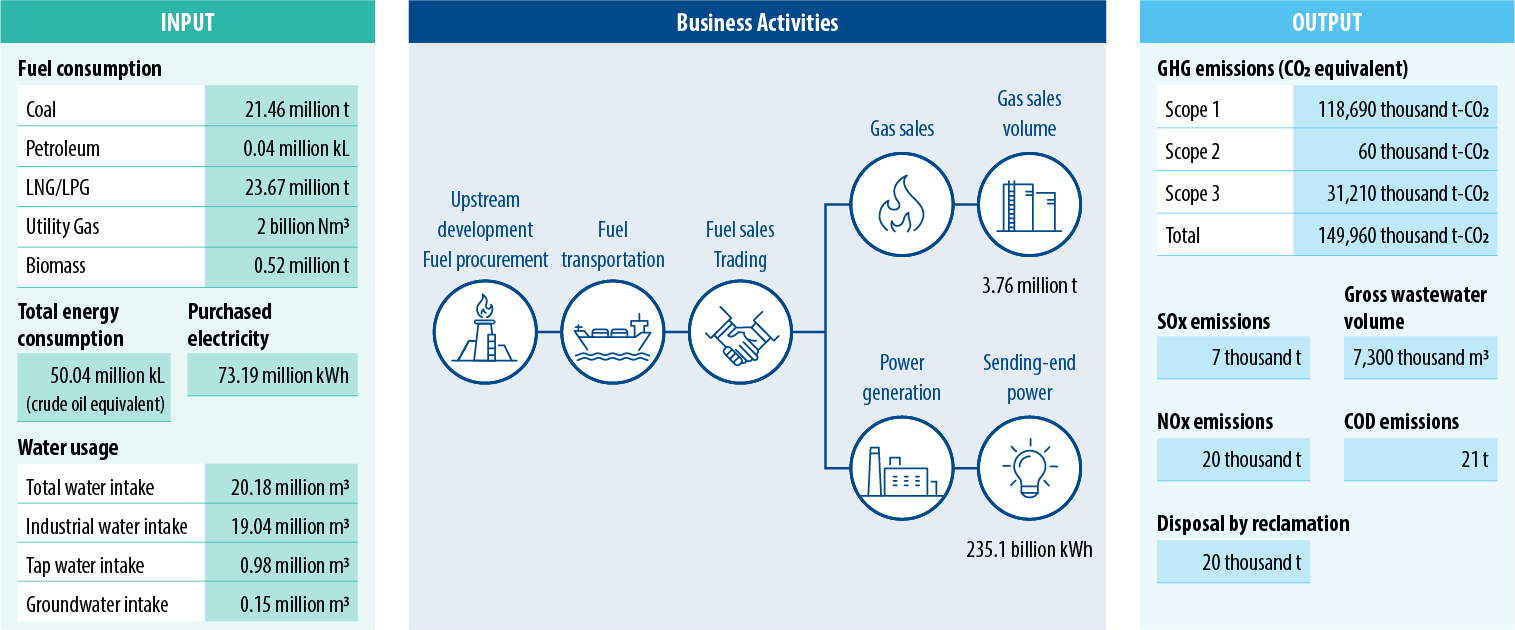
- Figures for JERA operations in Japan and joint ventures with Hitachinaka Generation Co., Inc., JERA Power TAKETOYO LLC, JERA Power YOKOSUKA LLC, and JERA Power ANEGASAKI LLC
Reducing CO2 Emissions
In October 2020, we announced JERA Zero CO2 Emissions 2050 as our commitment to curbing CO2 emissions for the future. With our mission to provide cutting edge solutions to the world’s energy issues, we will take on the challenge of achieving net zero CO2 emissions from our operations in Japan and abroad by the year 2050 in order to realize a sustainable society.
We also continue to work on renewable energy initiatives, which includepro moting our business both in Japan and overseas and participating in related organizations. With offshore wind power, we have participated in overseas projects in the UK and Taiwan, and domestically, we are now considering projects in Hokkaido and the Tohoku region. In our solar power generation operations, in addition to participating in projects throughout Asia, we have signed a business alliance agreement with West Holdings in Japan and plan to develop facilities with a total capacity of more than 1 million kW by the end of FY2025. Additionally, we acquired Parkwind, a major offshore wind power operator in Belgium, and GPI, a leading domestic renewable energy company.
To reduce CO2 emissions from thermal power generation, we are pushing forward with the replacement of thermal power plants as well as demonstration tests that utilize hydrogen and ammonia. At Anegasaki Thermal Power Station, which was partially decommissioned in 2021, we have been upgrading to the latest Gas Turbine Combined Cycle (GTCC) technology for LNG thermal power generation. New Units 1–3, totaling 1.95 million kW, began commercial operations in August 2023.
We will promote the adoption of greener fuels and pursue zero-emission thermal power during power generation. We aim to realize zero emissions by supplementing the introduction of renewable energy, which is susceptible to natural conditions, with zero-emission thermal power, which can generate electricity in a stable manner without CO2 emissions.
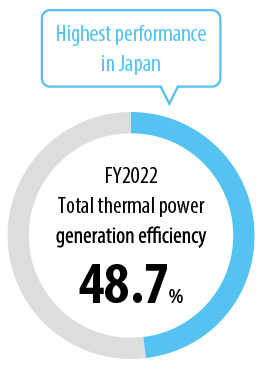
New Units 1–3 at Anegasaki Thermal Power Station: A state-of-the-art LNG-fired power plant using Gas Turbine Combined Cycle (GTCC) technology
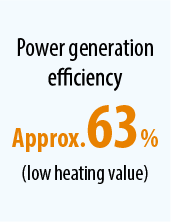
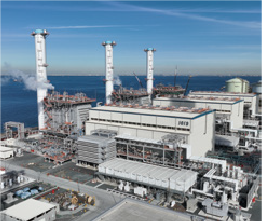
Preventing Air Pollution
Air pollutants emitted from our thermal power plants include sulfur oxides (SOx), nitrogen oxides (NOx), soot, and dust, primarily from boiler exhaust. In order to comply with emission standards set by laws and ordinances as well as environmental conservation agreements with municipalities, we are improving combustion methods and working to reduce emissions by installing exhaust gas desulfurization equipment, exhaust gas denitration equipment, electrostatic precipitators, and other equipment. In FY2022, our SOx and NOx emissions per unit of production were 0.03 g/kWh and 0.07 g/kWh, respectively, which are extremely low compared to emissions per unit of production in Japan and major Western countries.
SOx and NOx Emissions Per Unit of Power Generation Output in Major Countries for 2020 (Power Generation Output)
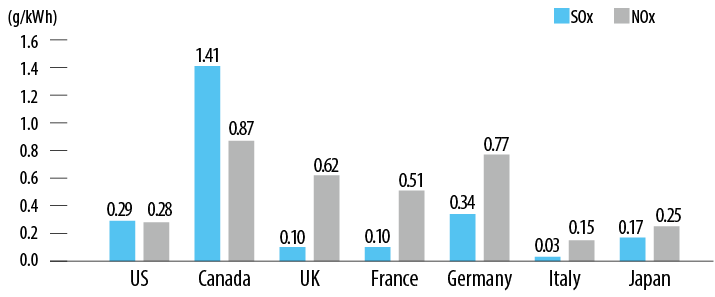
Source: Based on OECD Stat Extracts (for SOx and NOx emissions) and IEA World Energy Balances 2022 (for power generation output)
Featured
Independent Assurance on Environmental Data
To improve the credibility of our environmental data, starting with values reported for FY2021, we have received independent third-party assurance from KPMG AZSA Sustainability Co., Ltd. for certain environmental data, including GHG emissions, which is available on our corporate website.
Participation in the GX League

Green transformation (GX) refers to the transformation of the entire economic and social system to achieve emission reductions and increase industrial competitiveness by viewing initiatives to achieve greenhouse gas reduction targets as an opportunity for economic growth.
In line with our mission to provide cutting edge solutions to the world’s energy issues, we have announced our target of JERA Zero CO2 Emissions 2050 and are committed to achieving net zero CO2 emissions from our operations in Japan and abroad by the year 2050. We believe that our efforts align with the objectives of the GX League and have continued our involvement, announcing our formal participation in the league following our endorsement of the GX League Basic Concept in 2022.
We will continue to take the lead in the decarbonization of the energy industry by proactively developing decarbonization technologies and by working with related institutions, organizations, and stakeholders to resolve various issues.
Water Quality Conservation Measures(Consideration for Marine Environments)
Wastewater generated by our thermal power plants is purified by wastewater treatment facilities in order to comply with the effluent standards of laws and ordinances, as well as environmental conservation agreements we have with municipalities. We discharge this wastewater appropriately while monitoring it using continuous water quality measurement equipment. In addition, to keep the temperature of the seawater used in the condenser from rising, we take it in slowly from the deeper layers where the temperature is lower. When discharging it, we do so slowly to the surface by reducing the discharge velocity, giving full consideration to the environmental impact on the surrounding sea.
Initiatives Related to Resource Recycling
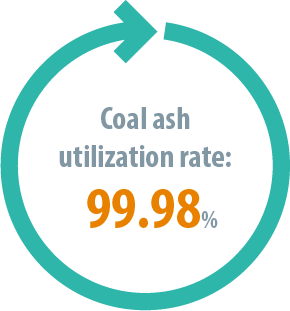
Furthermore, in compliance with the Act on Promotion of Resource Circulation for Plastics (commonly referred to as the Plastic Resource Circulation Act), we are proactively working to reduce and reuse industrial plastic waste generated from our business activities. The amount of waste plastic discharged and the effective utilization rate in FY2022 were 472 tons and 96.88%, respectively.
State of Waste Treatment Facility Maintenance
The Waste Management and Public Cleansing Act requires that information onthe st atus of the maintenance and management of waste treatment facilities be made public. We properly maintain and manage the appropriate waste treatment facilities and provide online reports regarding facility maintenance (type and amount of waste disposed of, results of water quality measurements performed on discharged water, facility inspection results, etc.).
Control of Chemical Substances
We observe the requirements of the Pollutant Release and Transfer Register Act (PRTR) for chemical substances used at thermal power plants and are working on strict control and reduction of emissions based on internal rules.
Compliance with Environmental Legislation
We make efforts toward environmental conservation by conducting business in accordance with environmental laws and regulations as well as local ordinances and environmental conservation agreements with municipalities. In FY2022, there were no cases involving fines or sanctions for violations of environmental laws and regulations.
Environmental Impact Assessments and Consideration of Environments Surrounding Power Plants
When constructing or replacing power plants, we conduct assessments of the environmental impact on the surrounding environment both during construction and after the plant is operational in accordance with the Environmental Impact Assessment Act. We then explain the results to the municipality and community members and engage in dialogue with them.
Based on the results of these environmental impact assessments, we strive to conserve the surrounding environment by implementing appropriate noise and vibration control measures, industrial waste control measures, and landscape preservation measures, taking into consideration the impact on the surrounding environment.
Primary Measures
| Measure | Description |
|---|---|
| Measures for Noise and Vibration Control | Our noise and vibration control measures include choosing the proper placement of buildings and equipment, adopting equipment for reducing noise and vibration, and installing silencers and sound barriers. |
| Measures for Industrial Waste Control | We take steps to properly treat waste by creating manuals tailored to the operations of individual thermal power plants. |
| Measures for Landscape Preservation | We make efforts to ensure that power plants blend in with local scenery while considering costs. |
Preserving Biodiversity
When endangered plants and animals are identified in the environmental impact assessment, we take steps to preserve biodiversity, including efforts to maintain and restore habitats and ecosystems.
The environmental impact assessment conducted when replacing the Yokosuka Thermal Power Station (Units 1 and 2) showed that the area was inhabited by falcons, which are designated as a rare endangered species in Japan. Accordingly, we have taken measures to avoid affecting their habitat, which included using lownoise, low-vibration machinery during construction. We’ve also installed nesting boxes for falcons in our stacks to create an environment conducive to nesting. We will continue our efforts to preserve the habitat by maintaining green areas.
Chita Thermal Power Station is also participating in the “Project Linking Life with One Another” by the non-profit Japan Ecologist Support Association. We view the coastal environment of the Chita Peninsula as a single ecosystem, and in collaboration with other businesses, local governments, experts, non-profit organizations, and students, we are working to enhance biodiversity and establish an ecological network.

